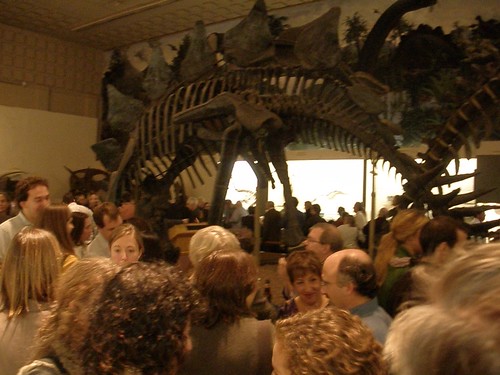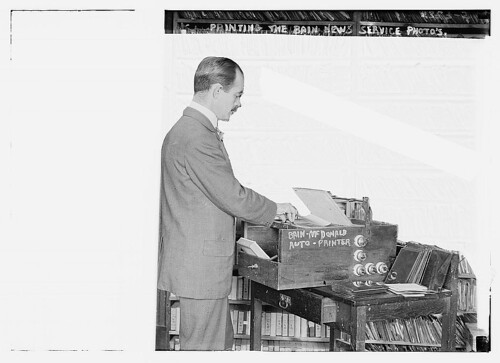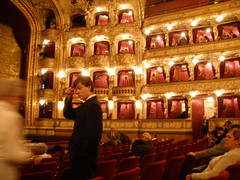 |
| Courtesy of the State Library and Archives of Florida via Flickr |
The science behind turkey magic
Cooking the Thanksgiving bird a mix of physical, chemical reactions
By DANIELLE VENTON
Herald Staff Writer
Posted: 11/25/2010 01:30:43 AM PST
Updated: 11/25/2010 01:30:44 AM PST
In kitchens across the nation today, as cooks prepare the Thanksgiving bird, the oven will be the object of a near-magical transformation.
A raw, unappealing, plucked gobbler will go in. If all goes well, a tender, browned, aromatic wonder will come out.
The change is the result of a host of physical and chemical reactions. For the curious, an investigation into the science of cooking the grand old bird offers useful insights.
Ever had turkey tartare? Not likely. Meat such as beef and fish is tender and flavorful when rare. When prepared properly, these can be relatively clean as well. But undercooked poultry is a tough, bland, bacterial growing ground.
Cooking addresses each problem. High heat kills bacteria. Cooking unravels protein fibers making the meat more tender and easier to chew. Cooking — in particular, browning — creates wonderful scents and flavors that make our mouth water.
Banishing the bugs
Poultry preparation requires special vigilance. An uncooked turkey carries potentially dangerous bacteria on the outside and the inside of the carcass. When turkeys are slaughtered and eviscerated, their intestines are unavoidably punctured.
"When they are cleaned, some of their feces are spread around the inside of the bird, and the outside," said food safety expert Benjamin Chapman, from North Carolina State University.
"The inside of the bird is actually the most contaminated part."
Cooking your bird to an internal temperature of 165 degrees Fahrenheit will kill any bacteria. But, Chapman cautions, turkeys need to be cooled properly. He suggests separating uneaten portions in medium-size plastic bags and laying them in the refrigerator to cool. Leaving cooked meat around for longer than two hours will only invite other bacteria to grow.
"It's quite complicated to prepare a large meal for 10 to 15 people and to get the timing right for everything," he said. "Good safety is important to pay attention to, though, because we see a spike in food poisoning outbreaks around the holidays every year."
Tricky timing
While you faithfully cook your bird to 165 degrees, what is happening to it?
Cooking softens meat by unraveling coiled muscle fibers and connective tissue. But overcooking will squeeze out the moisture in the meat and congeal the muscle fibers, leaving it tough and dry.
Brining a turkey — soaking it in salty water — moistens the meat and infuses salt throughout the bird. Salt allows protein fibers to hang onto more water while cooking.
Cooks should be aware the temperature will continue to rise inside the bird a few degrees, even after it is removed from the oven. Heat from the hotter outside of the bird will continue to transfer inward, so it should be taken out 5 to 10 degrees prior to the desired temperature. A 20-minute "standing time" will redistribute the meat's juices and let some muscle fibers that have contracted under the heat to relax. The turkey is then easier to carve.
Infrequent flyers
One of the reasons the Thanksgiving roast is such a challenge is that turkeys have two very different types of meat — each needing slightly different cooking temperatures.
Turkeys spend most of their life on their feet. Their attempts at flying are rare and pathetic. Their leg muscles are stronger and tougher than the rarely-exercised light breast meat. This is because leg meat stores more fat and pigments. The primary pigment is myoglobin, which helps muscles store oxygen and results in a denser meat.
For full effect, the dark meat needs 180 degrees. Breast meat is best when it reaches approximately 165 degrees Fahrenheit. Alton Brown of the Food Network's "Good Eats" suggests a highly specific 161.
Cooks have several suggestions about how to achieve this temperature differential.
Food science expert Harold McGee, author of "Keys to Good Cooking," suggests securing ice packs to the breast meat while thawing so the different sections of the bird begin cooking at different temperatures. Brown recommends making an aluminum shield to deflect some heat from the breast. Some cooks prepare the bird upside down. The simplest method is probably to cut the legs from the body and cook separately.
Mysterious chemistry
The chemistry of what actually makes a browned bird taste so good is still a subject of some mystery. High temperatures cause proteins and sugars to break down and react with each other. By themselves, the molecules don't have any aroma — they are too large to escape into the air. Our sense of taste is primarily based on our nose, so if we can't smell it, we can't taste it.
But when the proteins and sugars combine under high temperature, they create hundreds of new compounds small enough that we can smell and taste them. Researchers have been cataloging the tempting molecules for more than 100 years. More than 500 have been identified in poultry, and there are new ones to be discovered.
To achieve a brown, tasty crust on your bird, McGee recommends starting out at a high temperature. After the browning is out of the way — and the flavors that make our mouth water have been created — turn down the heat to monitor the bird's internal temperature. Doing this in the reverse — slow cooking followed by high temperature searing — makes it easy to overshoot the target temperature.
Assuming you have achieved scientific perfection with your 20-pounder, pour yourself a large glass of wine. Inhale deeply. See how many of the 500 turkey flavors you can smell. Grab that knife and fork. And have at it. Enjoy!
Danielle Venton can be reached at 646-4358 or dventon@montereyherald.com.











.jpg)





















 The Worldwide LHC Computing Grid (WLCG) collaboration has been in place since 2001 and for the past several years it has continually run the workloads for the experiments as part of their preparations for LHC data taking. So far, the numerous and massive simulations of the full chain of reconstruction and analysis software could only be carried out using Monte Carlo simulated data. Now, for the first time, the system is starting to work with real data and with many simultaneous users accessing them from all around the world.
The Worldwide LHC Computing Grid (WLCG) collaboration has been in place since 2001 and for the past several years it has continually run the workloads for the experiments as part of their preparations for LHC data taking. So far, the numerous and massive simulations of the full chain of reconstruction and analysis software could only be carried out using Monte Carlo simulated data. Now, for the first time, the system is starting to work with real data and with many simultaneous users accessing them from all around the world.




